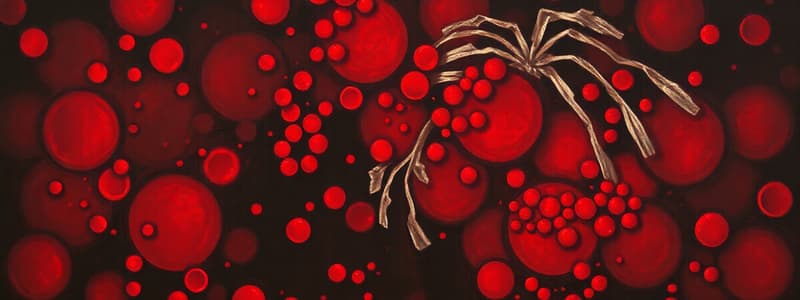Podcast
Questions and Answers
What is one main function of blood related to bodily fluids?
What is one main function of blood related to bodily fluids?
- It absorbs nutrients from food in the intestines.
- It generates energy for muscle contraction.
- It acts as a barrier against pathogens.
- It regulates the composition of interstitial fluid. (correct)
What is the primary purpose of hematopoiesis?
What is the primary purpose of hematopoiesis?
- To eliminate pathogens from the bloodstream.
- To regulate body temperature.
- To transport oxygen to tissues.
- To produce blood cells in the bone marrow. (correct)
Which of the following describes polycythemia?
Which of the following describes polycythemia?
- A decrease in red blood cell count.
- A deficiency of hemoglobin in blood.
- An increase in white blood cell activity.
- Increased production of red blood cells. (correct)
How are old red blood cells primarily removed from circulation?
How are old red blood cells primarily removed from circulation?
What are common symptoms of anemia?
What are common symptoms of anemia?
What is the primary function of plasma proteins in the blood?
What is the primary function of plasma proteins in the blood?
What percentage of total blood volume do red blood cells constitute in a healthy male?
What percentage of total blood volume do red blood cells constitute in a healthy male?
Which of the following describes a symptom of anemia?
Which of the following describes a symptom of anemia?
Which cells are primarily responsible for the defense against pathogens?
Which cells are primarily responsible for the defense against pathogens?
What is the role of transferrin in the blood?
What is the role of transferrin in the blood?
Which component of blood is primarily involved in blood clotting?
Which component of blood is primarily involved in blood clotting?
What is the primary consequence of polycythemia?
What is the primary consequence of polycythemia?
How does blood regulate body temperature?
How does blood regulate body temperature?
Flashcards
Functions of blood
Functions of blood
Transports gases, nutrients, hormones, and wastes; regulates interstitial fluid.
Hematopoiesis
Hematopoiesis
The process of forming new blood cells in the body.
Red blood cell synthesis
Red blood cell synthesis
The creation of red blood cells that transport oxygen throughout the body.
Removal of old red blood cells
Removal of old red blood cells
Signup and view all the flashcards
Anemia symptoms
Anemia symptoms
Signup and view all the flashcards
Hematocrit
Hematocrit
Signup and view all the flashcards
Plasma Functions
Plasma Functions
Signup and view all the flashcards
Albumins
Albumins
Signup and view all the flashcards
Globulins
Globulins
Signup and view all the flashcards
Fibrinogen
Fibrinogen
Signup and view all the flashcards
Erythrocytes
Erythrocytes
Signup and view all the flashcards
Anemia
Anemia
Signup and view all the flashcards
Polycythemia
Polycythemia
Signup and view all the flashcards
Study Notes
Blood Functions
-
Transports gases, nutrients, hormones, and metabolic waste
-
Regulates interstitial fluid composition (pH, ions, water)
-
Limits fluid loss at injury sites through blood clotting
-
Defends against toxins and pathogens
-
Regulates body temperature by absorbing and redistributing heat
-
Average blood volume for a 70 kg male is 5 L, 4 L for a 58 kg female
Blood Constituents
- Blood is composed of plasma (46-63%) and formed elements (37-54%)
- Normal hematocrit (packed red blood cell volume): males 40-54%, females 37-47%
Plasma Components
- Primarily water (92%)
- Proteins (made by liver):
- Albumins: colloid osmotic pressure, carriers
- Globulins: clotting factors, enzymes, carriers, antibodies
- Fibrinogen: forms fibrin in blood clotting
- Transferrin: iron transport
- Amino acids, glucose, lipids, trace elements/vitamins, gases (O₂, CO₂), and nitrogenous waste
Formed Elements
- Primarily red blood cells (erythrocytes) (99.9%)
- White blood cells (leukocytes) (0.1%):
- Lymphocytes (20-40%)
- Monocytes (2-8%)
- Granulocytes (50-70%): neutrophils, eosinophils, basophils
- Platelets (thrombocytes)
Hematopoiesis
- Blood cell production
- In embryos: yolk sac, liver, spleen, bone marrow
- Adults: pelvis, spine, ribs, cranium, proximal ends of long bones
- Bone marrow: 25% erythrocytes, 75% leukocytes
- Stem cells: pluripotent hematopoietic stem cell → committed progenitor cells → specific cell types (e.g., erythroblast, megakaryocyte)→ mature cells (e.g., erythrocyte, platelets)
Cytokines in Hematopoiesis
- Regulate hematopoiesis
- Erythropoietin (kidney): influences red blood cell development
- Thrombopoietin (liver): influences megakaryocyte development
- Colony-stimulating factors, interleukins, stem cell factor: influence development of all blood cell types
Red Blood Cells (Erythrocytes)
- Biconcave discs
- Filled with hemoglobin and enzymes
- ~5 million RBCs/µL of blood
- Transport oxygen and carbon dioxide
- ~270 million hemoglobin molecules/RBC
- Hemoglobin: iron atom, globin (alpha and beta chains), heme
- Life span: ~120 days
Erythropoiesis
- Red blood cell production
- Stimulated by low oxygen levels (hypoxia)
- Requires iron, vitamin B12, and folate
- Involves hypoxia-inducible factor (HIF1a) activating erythropoietin gene expression
- Mature RBCs lack a nucleus (no new transcription)
- Anaerobic metabolism
Red Blood Cell Removal
- Aged/damaged RBCs are removed by macrophages in spleen, liver, and bone marrow
- Hemoglobin is broken down
- Iron is conserved
- Heme is converted to bilirubin and excreted in bile
- Bilirubin is excreted in the urine and faces
Jaundice
- Condition due to high bilirubin levels
- Caused by high turnover of RBCs, liver disease, and bile duct obstruction
Anemia
- Reduced oxygen-carrying capacity of blood
- Low RBC count or low hemoglobin levels
- Symptoms: Tired, weak, pale skin, headaches, dizziness, etc.
- Types:
- Low production: stem cell destruction (aplastic), inadequate nutrients, low erythropoietin
- High removal: hemolytic anemia (genetic defects, parasitic infections, drugs, autoimmune reactions), hemorrhagic anemia (excessive blood loss)
Polycythemia
- Abnormally high hematocrit (>~54%)
- Causes: abnormal erythrocyte precursors, low oxygen delivery to tissues
- Result: high blood viscosity
Studying That Suits You
Use AI to generate personalized quizzes and flashcards to suit your learning preferences.



